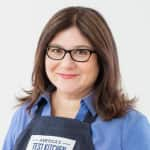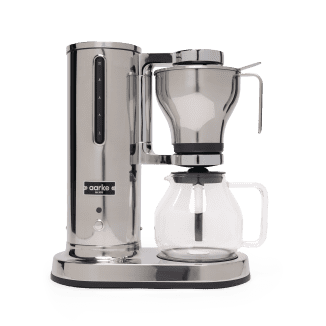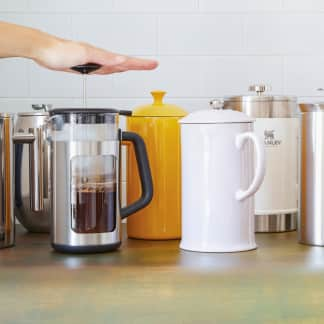We tested automatic drip coffee makers at various price points, seeking models that brewed flavorful, hot coffee and were easy to use. Our favorite is the Technivorm Moccamaster KBT. Its powerful copper boiler quickly heats and holds water at a precise temperature for coffee that tasters described as “very strong but smooth.” Besides its single on/off control and clean design, we also loved its five-year warranty and its easily replaceable exterior parts, which ensure a long, useful life. We also recommend the OXO Brew 8-Cup Coffee Maker for the good coffee it makes as well as its compact profile, intuitive controls, and the most ergonomically pleasing carafe we’ve seen in years of testing. Our Best Buy is another compact model: the Zojirushi ZUTTO Coffee Maker. While we’re not fans of its glass carafe, it brewed very good coffee. We loved its removable water tank, simple controls, and easy cleanup. For those who want the convenience of waking up to fresh coffee in the morning, we recommend the Fellow Aiden Precision Coffee Maker; it brewed tasty coffee and was easy to set up.

In our testing, we were astonished by how different coffee makers could make the same two ingredients—identically prepared ground coffee and water—taste wonderful or terrible. We looked high and low for a machine that would produce delicious, perfectly brewed, piping hot coffee every time with minimal fuss. We started by choosing from a list of home coffee makers certified as good performers by the Specialty Coffee Association (SCA), a coffee-industry group focused on improving coffee quality through education and scientific standards, and rounded out our lineup with promising models that were not on their list, testing machines with a wide range of prices. Here’s what we learned after brewing, testing, and drinking gallons of coffee.



Our tasters sampled coffee brewed in each machine (left). We saw different flavors and bodies among coffee samples in the tasting (right), even though they were brewed with the same coffee grounds and water.
How Does an Automatic Drip Coffee Maker Work?
The most basic automatic drip coffee makers mimic the technique used to make handmade pour-over coffee, but the machine takes care of heating water and distributing it over the coffee grounds. After you fill the water reservoir, add coffee to the filter-lined brewing basket, and hit the on button, the machine takes over. The metal heating element inside—usually aluminum but sometimes copper (a metal that’s more than twice as fast as aluminum at transmitting heat)—heats up, warming the water as it passes from the reservoir through a narrow tube alongside the element. This creates steam that forces the hot water up the tube, through a one-way valve, and out over the coffee grounds. The hot water extracts flavor compounds and oils and tiny coffee particles from the grounds and then drips down through the filter, out of the basket, and into the carafe.
More advanced coffee makers can adjust brew times based on the types of coffee used; some include multiple brew baskets for different styles and sizes of coffee.
Should You Buy a Programmable Coffee Maker?
It depends. Some models let you set a timer so that you can have coffee ready at a certain time in the future. In general, we aren’t fond of these programmable models. Having the grounds and water sit for hours before brewing could make the coffee taste stale. That said, we recognize that many people love being able to have coffee ready in the morning and might be willing to sacrifice some coffee quality as a result. For these folks, we recommend the Fellow Aiden Precision Coffee Maker because it’s intuitive to use and brewed good coffee when we used fresh grounds.
What Is Total Dissolved Solids (TDS)? What Is Extraction Percentage?
To help us understand how well each coffee maker brewed coffee, we started with measuring Total Dissolved Solids (TDS). TDS shows how much dissolved material is in the brewed coffee. Higher levels of dissolvable compounds mean more flavors, both good and bad, are present in the coffee (this translates to a stronger-tasting cup); lower levels of TDS indicate fewer dissolvable compounds are present in the coffee. The Specialty Coffee Association puts the desired TDS range for drip coffee at 1.15 to 1.55 percent, but in reality the “ideal” TDS is a matter of personal taste and can also depend on the type of coffee, how coarsely or finely it’s ground, and other factors.
We then calculated each sample’s extraction percentage, which is the percentage of the flavor compounds (dissolved solids) that are brewed into the cup, in comparison to the weight of the original grounds. Coffee is a complex agricultural product that contains more than 1,000 organic flavor compounds. During brewing, only a small percentage of it is extracted. Generally speaking, if the extraction percentage of your coffee is low, that means you’re leaving flavor in the beans that might be delicious; if your percentage is high, you might be overextracting the bean and getting undesirable flavor. The SCA’s guidelines put the ideal extraction range for drip coffee from 18 to 22 percent, meaning that about 18 to 22 percent of the total weight of the coffee is extracted into a brewed cup. That said, in practice, the “right” extraction percentage depends a lot on personal preference, as with TDS.
The bottom line? While TDS and extraction data can be useful in understanding coffee quality, our tasting panel’s opinions were ultimately the most important factors in determining our ratings.
What to Look For
- Great Flavor: Your coffee maker should make coffee you’ll actually enjoy drinking. Coffee makers may have a similar look and seem like a fairly basic piece of equipment, but many factors can determine the quality of the coffee they produce, including brew temperature (discussed below), the shape of the brew basket, and water flow rate. For each machine, we evaluated certain benchmarks of coffee quality used by the coffee industry, total dissolved solids (TDS) and extraction percentage (see inset). That said, this data did not solely determine our rankings. Ultimately, great coffee is an alchemy of many factors (plus quality coffee beans and good-tasting water). And personal taste is important too. In the end, the information that mattered most was whether our panel of 21 people thought a machine’s coffee tasted good.
- Simple, Intuitive Controls: Anyone should be able to operate the coffee maker with little effort. Don’t laugh; a couple of these machines were ridiculously complex, with a steep learning curve. We preferred pared-down designs with intuitive switches, markings, and/or displays.
Making coffee should be easy. We preferred machines with a simple on/off switch.
- Correct-Size Brewing Basket: Brewing baskets must be big enough to hold plenty of ground coffee for a suitable coffee-to-water ratio. Not all machines could hold the 55 grams of coffee needed to meet the SCA standard for 1 liter of water. Several had 64-ounce (1.8-liter) water tanks paired with fairly petite brewing baskets, which sometimes overflowed when we made a full pot of coffee using the SCA ratio. If we reduced the grounds, the coffee was weak. In short, huge water tanks should be matched by roomy brewing baskets.


Some coffee makers we tested had brewing baskets that weren't big enough to accommodate the volume of water held by their water tanks. While the brewing basket on the left was adequately sized, coffee overflowed in the basket on the right.
- Hot Water: Good coffee requires water that’s heated to a fairly high temperature—the SCA recommends water heated from 194 to 205 degrees Fahrenheit. Lower-temperature water favors the extraction of sour compounds while leaving out sweet and bitter ones, which results in coffee that tastes sour and weak. Similarly, higher-temperature water extracts more harsh, bitter flavors from the coffee beans. The SCA specifies that the water should remain within the range of 194 to 205 degrees for the entire brewing cycle. We tracked the water temperature of every machine during operation and found that few machines were able to stay in that zone the whole time. Still, some machines that failed this test made excellent coffee regardless. Having water that hits the grounds at a relatively hot temperature matters for another reason: We’ve also found that most people like to drink piping-hot coffee, so when the brewing temperature is too low to begin with, the coffee starts at a less desirable drinking temperature and cools off faster too. (We’ve noted the temperature of every machine’s freshly brewed coffee in our chart.)
- Thermal Carafe: Keeping fresh coffee hot without scorching it is easiest when the machine brews into an insulated thermal carafe. We also prefer sturdy stainless-steel thermal carafes to glass carafes, as glass can shatter (forcing you to locate and buy a replacement).
- Clear, Accurate Instructions: A manual should clearly spell out how to operate the machine and how much coffee you should use for different volumes of water. (Machines that recommended using SCA’s widely accepted science-based coffee-to-water ratios earned bonus points.)

- Easy Cleanup: Removing filters with spent coffee grounds should be a simple and neat process. We also liked carafes that were easy to scrub, with well-designed lids that didn’t trap water.
A handle on our winner's basket was simple to grasp and made it easy to dump out the spent grounds without touching them.
- Neat, Comfortable Pouring: Carafes should be comfortable to hold and easy to control for accurate pouring without splashing or dribbling.
Some carafes poured neatly and comfortably.
- Visible Water Tank Fill Lines: Water fill line indicators should be easy to read. Bailing water out of an overfilled reservoir is a pain. We appreciated models with removable water tanks.
What to Avoid
- Fussy, Confusing Controls: You shouldn’t have to constantly consult the manual to figure out how to operate a coffee maker. The learning curve of some machines was too steep, requiring users to master puzzling symbols and special sequences for dialing and pushing various buttons—just to make a basic pot of coffee.
Making coffee should be easy. We didn't like machines with multiple dials, lights, symbols, and buttons.
- Undersized Brewing Baskets: One machine consistently overflowed when we used the correct SCA coffee-to-water ratio for a full pot, and a few others nearly overflowed. Their manuals suggested less than half the correct quantity of grounds needed to brew great coffee, given the size of their water reservoirs.

- Messy Brewing Baskets: Cleaning out coffee grounds and residue after brewing shouldn’t be hard or make a mess. We liked handles or other designs that helped us grab the brewing basket and neatly dump disposable filters or empty permanent ones.
We found it messy (and hot) to grab the brewing basket of this coffee maker.
- Vague (or Missing) Instructions for How Much Coffee to Add: We get that the amount of grounds each user chooses will vary according to taste, but manufacturers should provide guidelines that make sense. Some omitted this crucial information from their manuals.
- Drippy Carafes: A few of the carafes either dribbled or gushed coffee as we poured. Some were very heavy when full and made us hold down a tab on top of the handle while pouring, which was awkward. Others had lids that were tricky to put on. Worse, a few lids routinely trapped tablespoonsful of dishwater that drained out days later. Yuck.
Some carafes dribbled and splashed coffee and splayed our hands awkwardly, as we had to push levers and buttons while pouring.
- Glass Carafes with Heating Plates: Most coffee machines with glass carafes use the same element to heat the water and the hot plate—a recipe for scorched, bitter coffee. A few models had separate, gentler heaters and an automatic shutoff for the plate. We still found these problematic: They slightly overheated coffee before letting it go cold. If you typically don’t drink all your coffee right away, go for a thermal carafe. Plus, if you can’t find an affordable replacement for a broken glass carafe, the whole machine goes to the landfill.
Other Considerations
- “Strong” or “Bold” Settings: When machines offer this option, don’t choose it. It just makes the brewing cycle last longer, which results in overextracted grounds and bitter coffee.

- Coffee Scoops: Ground coffees have radically different weights and volumes depending on how they are roasted and how finely or coarsely they’re ground. Most machines came with coffee scoops, but these were misleading and useless. If you want good coffee, buy a scale and weigh your grounds.
The Tests
- Brew multiple full pots of coffee in each coffee maker
- Have 21 people rate coffee from each machine in a tasting with randomized samples
- Track the brewing water temperature and brewing cycle duration; calculate the percentage of the cycle spent in the ideal extraction temperature range of 194 to 205 degrees
- Measure the total dissolved solids (TDS) of the brewed coffee and calculate the percentage extraction
- Check the temperature of brewed coffee in the carafes (on their hot plates, where applicable) when freshly brewed, 1 hour later, and 2 hours later
- Evaluate other special features of individual coffee makers, if applicable
How We Rated
- Coffee Quality: We assessed the machines’ ability to meet industry standards for excellent coffee (including factors such as temperature, time, and water-to-coffee ratio) and rated the brewed coffees in a randomized tasting.
- Ease of Use: We noted whether the machines were easy, intuitive, and comfortable to handle and operate.
- Carafe: We rated the designs of the carafes, noting how comfortable they were to hold while pouring and how well they poured, and measured their heat retention in both thermal carafes and glass carafes on hot plates.
- Cleanup: We noted whether it was easy to keep machines and carafes clean, intact, and in good working order.












 Buy at OXO
Buy at OXO


















